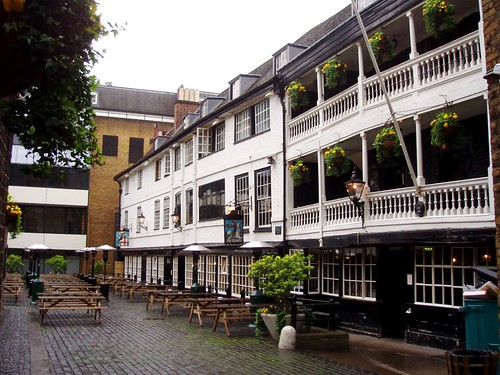It's been a very quiet start to 2020 here at Go Stay Work Play Live World Headquarters on board the Lucky Nickel. I’m stalled on two different work projects waiting for other people to do things, and motivation for any grand project or adventure has been low, so I’m contenting myself with minor boat maintenance and brief excursions into the outside world. (And a bit of wassailing of course.)
We’ve had some quite blustery weather of late, which along with the long travel times for me to get from the marina to anywhere besides Tesco, and the fact that dusk seems to come at about 3:15pm, has meant that I’ve been mostly cocooned in the boat listening to the ropes creak and bingeing on videos. As I said, I’m easing in.
Along with the foul weather and general aimlessness comes the desire for properly cozy food and the time to faff around with it. And since I’d rather cook up something yummy from the comfort of my home than venture out into the rain and wind to find something to blog about, it seemed a good time to pick from the list of potential GRUB! topics. Thus, Toad in the Hole! (Though I did ponder treacle tart quite seriously. All in good time.)
Toad in the Hole is a dish that falls into that enormous category of foodstuffs where meat - in this case sausages - is the star, supported and surrounded by a comforting carbohydrate of some form. The intention with these dishes is to stretch a small amount of an expensive ingredient into a meal for many people (like fish pie or, say, shaving black truffles over a big pot of Kraft Dinner.) I’ll admit now that I’d never had Toad in the Hole before I decided to try it out on this occasion, and if I’d given it any particular thought I suppose I’d assumed the the “hole” into which the toad sausage was planted was some kind of potatoey something-or-other.
(Pause for cries of shock and outrage)
Of course I was woefully misinformed on this subject. Toad in the Hole is, of course, comprised of sausages nestled in a crisp and tasty bed of Yorkshire pudding! This was a revelatory discovery and certainly put a bit more spring in my culinary step as I contemplated supper.
I suppose now I should pause because there’s a chance that somewhere out there in GSWPL-land there may be some sadly deprived readers who are living a grey and unfulfilled Yorkshire pudding-less existence. My condolences to you if you are one of those people, but cheer up because you are about to be introduced to the glory that is Yorkshire pudding!
First of all, this is one of those cases where we’re using the term pudding in its broadest possible sense meaning, basically, food. It’s not Bill Cosby Jell-o pudding custardy thing, and it’s not a chilled and set sweet thing like summer pudding. It’s also not a sweet steamed effort like sticky toffee pudding or Christmas pudding and it’s not a steamed savoury thing like steak and kidney pudding. Or even a sausagey sort of thing like black pudding. (And now I just have to pause and comment that I have blogged about a LOT of pudding.) Unaccountably, Yorkshire pudding is a light and airy baked affair that’s closest cousin is probably American style popovers. Which is to say that it’s a thin batter of flour, egg and liquid, baked with some fat and resulting in a crispy light puffed up golden brown thing that’s really really really good with gravy. Traditionally it’s made in a large baking dish and cut up to be served but it’s actually very common (at least when you’re not in Yorkshire) to get little individual Yorkshire puddings made in muffin tins. These little ones have the advantage of being mostly hollow when done correctly, meaning they are a perfect vessel for gravy.
So, Toad in the Hole is sausages in Yorkshire pudding. Simple. Filling. Sure to be delicious. And because it was sad to contemplate Yorkshires without gravy, I decided to whip up some onion gravy to go along, since it was mentioned in one of the recipes I found and gravy is pretty much always a good idea.
My effort was based on this recipe from the Guardian, though I’ve noted changes I made.
Toad in the Hole with Onion Gravy:
For the Toad:
6 sausages (I used 4. There’s only one of me and I suspected that a day’s worth of leftovers would be plenty.)
For the Hole:
3 tbsp beef dripping or good lard (I just used olive oil, which was the only oil I generally stock)
2 eggs
100g plain flour, sifted, plus 1 tbsp extra for the gravy. (Sifted? Who has time to sift? I’m unemployed and even I don’t have the time for that. Life is too short to sift.)
85ml whole milk
85ml ale (I think this is meant to add lightness to the batter but it’s probably very optional. Just make sure to end up with the right total amount of liquid.)
2 tbsp wholegrain mustard
1 tbsp neutral oil (Or perhaps might I suggest... olive oil?)
For the gravy:
2 medium onions
A bit more oil (Like maybe olive oil?)
500ml (2 cups) of beef stock (A stock cube is fine. This is not the Cordon Bleu.)
A bit of flour
Method:
1. Take the batteries out of the smoke detector. You’ll thank me later.
2. Put the oil/dripping in the pan and put it in the oven, which you are about to turn on.
3. Heat the pan with the oil to one million degrees. (This is the one thing that EVERYONE mentions about making Yorkshire pudding: you must get the fat in the pan very hot. Very, very hot. Mary Berry says “absolutely piping hot”. My mom says “screaming hot”. And my mate Simon says, “it should be one degree away from taking down the whole neighbourhood”. Note this might be slightly less that one millions degrees. Perhaps try setting the oven for 200-220ºC/400-450ºF.)
4. Brown the sausages and then set them aside. They’ll cook through in the oven, but won’t get that nice browned look without this step. Plus then you can use all the crunchy leftover bits in the pan for the gravy.
5. Make the batter by cracking the eggs into a large bowl and beating vigorously with a whisk or electric beater, until thick and voluminous. Beat in the flour and milk alternately in small amounts, until you have a smooth batter.
4. Add the ale and mustard and beat again. (At this point the batter will be worryingly runny and you might want to WhatsApp your mom if she is a seasoned Yorkshire pudding maker and send her a quick video of the runniness, after which she will assure you that it looks fine and mention AGAIN that the fat really must be very very VERY hot.)
5. Let the batter sit for a bit while you’re waiting for the oven rack to start melting, which is a good indication that the fat is almost hot enough. (This is the point at which I had the little boat oven turned up to gas mark nine, which is as high as it goes. That’s supposed to be equivalent to 275 deg c but was actually hovering around 200 on my oven thermometer. This is also the point at which I started to think my first Yorkshire puddings were not going to set any records for awesomeness.)
6. Get the fire extinguisher out of the cupboard and set it nearby. Remove the pan of hot fat from the oven and quickly pour in the batter, which should sizzle when it hits the oil. Add the sausages after that, take photo for your blog (optional), and then get the whole thing back in the oven. Bake for about 35 minutes until the batter has risen beautifully and is golden brown and delicious. (Alternatively, peer helplessly through the grease-spattered window of your inadequate oven trying to see if it’s rising at all.)
7. In between peering, get on with the gravy. Slice the onion thinly, add a bit more oil to the sausage pan, and get it all on the heat. The onion should cook slowly on low heat. Really slowly. They shouldn’t brown so much as melt. Help things along by adding a bit of stock to the pan.
8. Once the onions have cooked down a lot add most of the stock and let it cook down more to thicken. Once you get tired of waiting for it to thicken, add a spoon of flour to the remaining stock and mix it into a slurry and then pour that in to thicken things up because honestly who has time to wait for gravy to thicken when there is Yorkshire pudding to be had?
9. Get the Toad in the Hole out of the oven.
10. Put the batteries back in the smoke detector (do NOT forget this step) and put away the fire extinguisher.
11. Eat!
And that's Toad in the Hole, Lucky Nickel style. I also steamed some broccoli to go along with it, and even though the Yorkshire pudding was nothing like as high and light as it could have been, it still tasted like Yorkshire pudding, if a bit more dense. Plus I had almost a whole can of beer left and lots of gravy, so all in all I’m calling this a success and a very worthwhile way to spend an evening.
And photographing stunning sunrises like this one.
Along with the foul weather and general aimlessness comes the desire for properly cozy food and the time to faff around with it. And since I’d rather cook up something yummy from the comfort of my home than venture out into the rain and wind to find something to blog about, it seemed a good time to pick from the list of potential GRUB! topics. Thus, Toad in the Hole! (Though I did ponder treacle tart quite seriously. All in good time.)
Toad in the Hole is a dish that falls into that enormous category of foodstuffs where meat - in this case sausages - is the star, supported and surrounded by a comforting carbohydrate of some form. The intention with these dishes is to stretch a small amount of an expensive ingredient into a meal for many people (like fish pie or, say, shaving black truffles over a big pot of Kraft Dinner.) I’ll admit now that I’d never had Toad in the Hole before I decided to try it out on this occasion, and if I’d given it any particular thought I suppose I’d assumed the the “hole” into which the toad sausage was planted was some kind of potatoey something-or-other.
(Pause for cries of shock and outrage)
Of course I was woefully misinformed on this subject. Toad in the Hole is, of course, comprised of sausages nestled in a crisp and tasty bed of Yorkshire pudding! This was a revelatory discovery and certainly put a bit more spring in my culinary step as I contemplated supper.
I suppose now I should pause because there’s a chance that somewhere out there in GSWPL-land there may be some sadly deprived readers who are living a grey and unfulfilled Yorkshire pudding-less existence. My condolences to you if you are one of those people, but cheer up because you are about to be introduced to the glory that is Yorkshire pudding!
First of all, this is one of those cases where we’re using the term pudding in its broadest possible sense meaning, basically, food. It’s not Bill Cosby Jell-o pudding custardy thing, and it’s not a chilled and set sweet thing like summer pudding. It’s also not a sweet steamed effort like sticky toffee pudding or Christmas pudding and it’s not a steamed savoury thing like steak and kidney pudding. Or even a sausagey sort of thing like black pudding. (And now I just have to pause and comment that I have blogged about a LOT of pudding.) Unaccountably, Yorkshire pudding is a light and airy baked affair that’s closest cousin is probably American style popovers. Which is to say that it’s a thin batter of flour, egg and liquid, baked with some fat and resulting in a crispy light puffed up golden brown thing that’s really really really good with gravy. Traditionally it’s made in a large baking dish and cut up to be served but it’s actually very common (at least when you’re not in Yorkshire) to get little individual Yorkshire puddings made in muffin tins. These little ones have the advantage of being mostly hollow when done correctly, meaning they are a perfect vessel for gravy.
Yorkshire puddings made in a muffin tin, from Mary Berry’s recipe. Note that Yorkshire puddings are often simply referred to as “Yorkshires” or even simply “Yorkies” (Not to be confused with the dogs or the chocolate bars.)
The gathering of ingredients, along with the chosen baking dish.
Toad in the Hole with Onion Gravy:
For the Toad:
6 sausages (I used 4. There’s only one of me and I suspected that a day’s worth of leftovers would be plenty.)
For the Hole:
3 tbsp beef dripping or good lard (I just used olive oil, which was the only oil I generally stock)
2 eggs
100g plain flour, sifted, plus 1 tbsp extra for the gravy. (Sifted? Who has time to sift? I’m unemployed and even I don’t have the time for that. Life is too short to sift.)
85ml whole milk
85ml ale (I think this is meant to add lightness to the batter but it’s probably very optional. Just make sure to end up with the right total amount of liquid.)
2 tbsp wholegrain mustard
1 tbsp neutral oil (Or perhaps might I suggest... olive oil?)
For the gravy:
2 medium onions
A bit more oil (Like maybe olive oil?)
500ml (2 cups) of beef stock (A stock cube is fine. This is not the Cordon Bleu.)
A bit of flour
Method:
1. Take the batteries out of the smoke detector. You’ll thank me later.
2. Put the oil/dripping in the pan and put it in the oven, which you are about to turn on.
3. Heat the pan with the oil to one million degrees. (This is the one thing that EVERYONE mentions about making Yorkshire pudding: you must get the fat in the pan very hot. Very, very hot. Mary Berry says “absolutely piping hot”. My mom says “screaming hot”. And my mate Simon says, “it should be one degree away from taking down the whole neighbourhood”. Note this might be slightly less that one millions degrees. Perhaps try setting the oven for 200-220ºC/400-450ºF.)
4. Brown the sausages and then set them aside. They’ll cook through in the oven, but won’t get that nice browned look without this step. Plus then you can use all the crunchy leftover bits in the pan for the gravy.
5. Make the batter by cracking the eggs into a large bowl and beating vigorously with a whisk or electric beater, until thick and voluminous. Beat in the flour and milk alternately in small amounts, until you have a smooth batter.
I don’t have an electric beater, but I do have this nifty little hand-cranked food processor sort of thing that I got at a dollar store in Azerbaijan. I has a chopping blade, a whipping attachment and a basket for spin-drying greens. Genius little device, plus this was the first time I’ve got to use the whipping thingy, so yay!
5. Let the batter sit for a bit while you’re waiting for the oven rack to start melting, which is a good indication that the fat is almost hot enough. (This is the point at which I had the little boat oven turned up to gas mark nine, which is as high as it goes. That’s supposed to be equivalent to 275 deg c but was actually hovering around 200 on my oven thermometer. This is also the point at which I started to think my first Yorkshire puddings were not going to set any records for awesomeness.)
6. Get the fire extinguisher out of the cupboard and set it nearby. Remove the pan of hot fat from the oven and quickly pour in the batter, which should sizzle when it hits the oil. Add the sausages after that, take photo for your blog (optional), and then get the whole thing back in the oven. Bake for about 35 minutes until the batter has risen beautifully and is golden brown and delicious. (Alternatively, peer helplessly through the grease-spattered window of your inadequate oven trying to see if it’s rising at all.)
Optional Photo. Yes everything is kind of swimming in fat.
This is not a diet food situation, people.
8. Once the onions have cooked down a lot add most of the stock and let it cook down more to thicken. Once you get tired of waiting for it to thicken, add a spoon of flour to the remaining stock and mix it into a slurry and then pour that in to thicken things up because honestly who has time to wait for gravy to thicken when there is Yorkshire pudding to be had?
9. Get the Toad in the Hole out of the oven.
10. Put the batteries back in the smoke detector (do NOT forget this step) and put away the fire extinguisher.
11. Eat!
The finished dish. Not much rise on the Yorkshire pudding, but the gravy’s looking decent.














